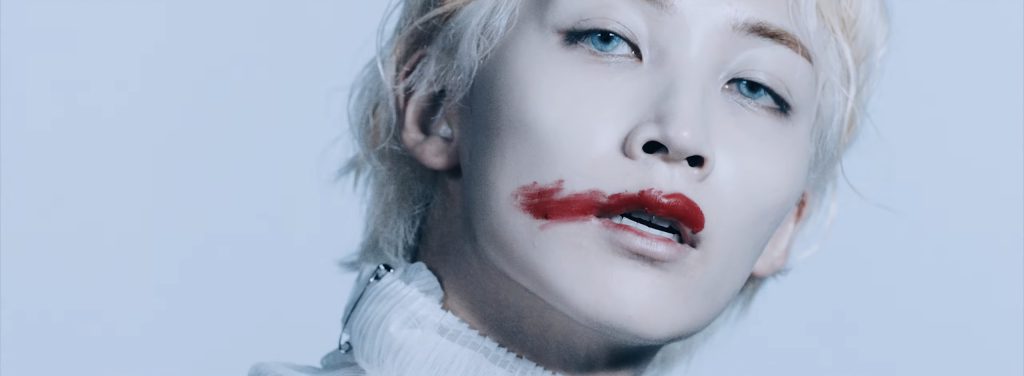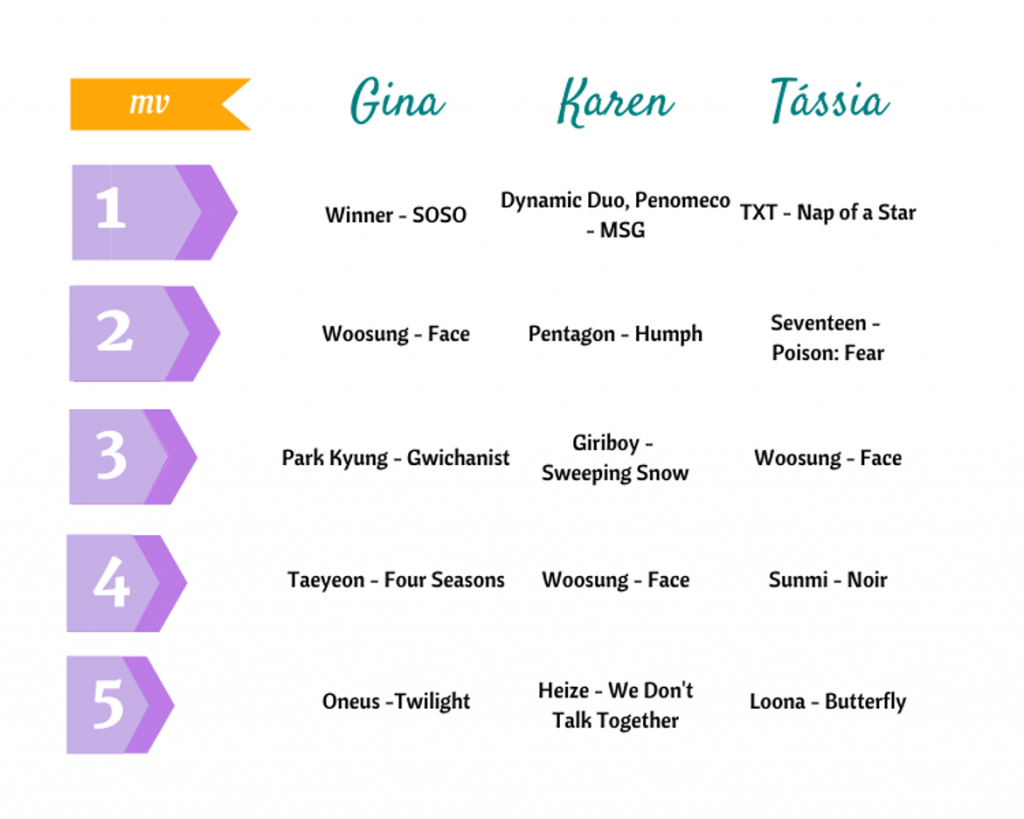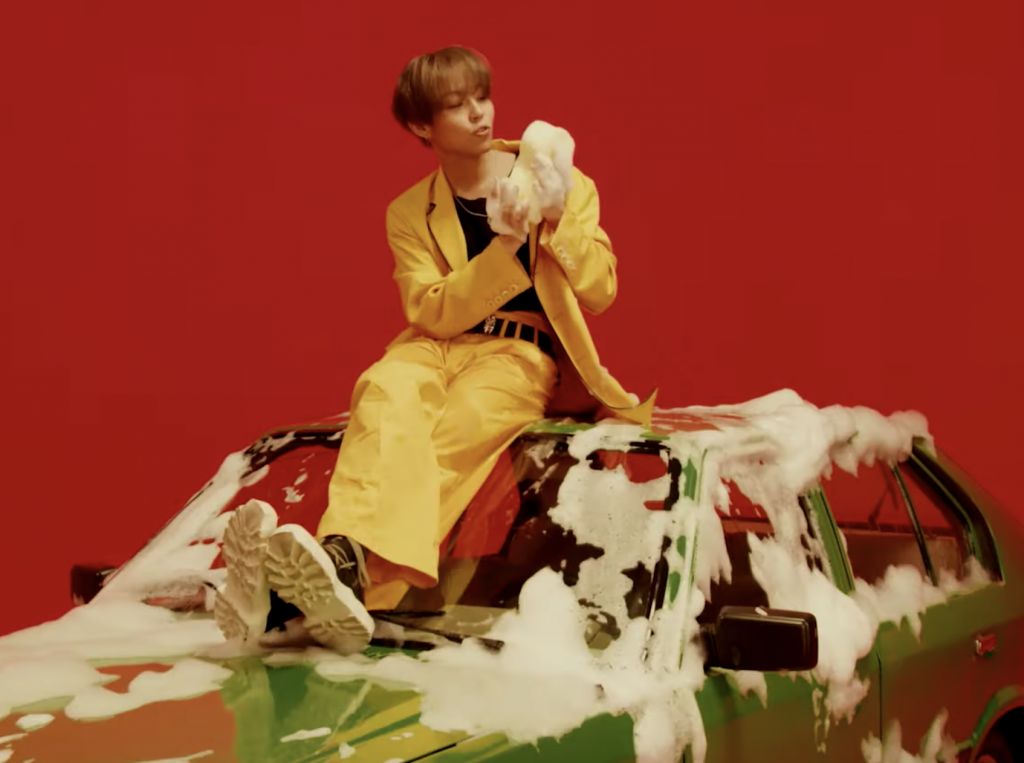
Stunning K-pop MVs require mastery in the art of marrying music, performance, and cinematography. 2019 has not been the most spectacular year for MV releases, but Karen, Gina, and Tássia discuss how they come to be enthralled by unconventional aesthetic and thematic choices.

Karen: The K-pop landscape for the second half of 2019 was rather barren for me in terms of MV releases, but we all have Woosung‘s “Face” on our lists. What made the MV stand out?
Tássia: It was hard to choose, but I love how wildly different our lists are. Most MVs in 2019 were aesthetically stunning (as usual in K-pop), but few added nuances beyond that. Woosung surprised me because of his minimalistic yet meaningful approach. He didn’t need extravagant sets or an infinite budget to deliver a clear, original message. In fact, the simplicity of “Face” is what makes it stand out. I also liked the inclusion of diverse models and all the clever innuendos that fit in with the song’s lyrics. It felt like a perfect depiction of Woosung’s persona, too — warm, cheeky, and irresistibly charming. I didn’t know much about The Rose before this solo, but certainly started to pay attention since then.
Gina: For me, it was his daring artistry that won me over. The idea of admiring one’s face in itself is nothing new, and may have been redundant if Woosung took a safe, conventional direction. Instead, he invoked a stylistic approach to his concept that added depth to the track’s message. He took this chance to showcase his own colors, with the notion that this song goes out to everyone.
The visual presentation of the MV further drives this point. Personal touches such as an orange aesthetic, unique guest models, and little nuances of symbolism — milk glass, cherries, gummies — made it one-of-a-kind in a simple way. Like Tassia says, it showcased his artistic vision in a nutshell. In these ways, the song and MV worked to show a complete picture. What about you, Karen?
Karen: I totally agree with what the both of you have mentioned regarding its stunning minimalist aesthetic, inclusion of guest models, and straight-forward yet nuanced symbols. Personally, the MV’s visual representation of fluidity was what really caught my attention.

“Face” has a grooving rhythm to its melody, which was beautifully captured in the MV’s visual juxtaposition of static items, sets, people, with other elements of movement. There is also the use of camera angles and more gender fluid appearances of the guests that add to the notion of fluidity.
It seems that “Face”’s greatest appeal for all three of us would be its ability to marry simplicity with novelty and the unconventional. Would you say this is true of your other picks? Or were there other approaches that made them stand out?
Gina: I definitely agree that in the midst of aesthetic but insubstantial MVs, “Face” stood out through utilizing this multi-faceted approach. Other MVs that come to mind are Taeyeon’s “Four Seasons” and Park Kyung’s “Gwichanist.”
To start, “Four Seasons” swept me off my feet with how creative and classy it was. Similar to “Face,” this MV included a combination of still and individual shots — scenes in which Taeyeon is juxtaposed against nature or a contrasting profile shot. Each scene in the MV proved to be unpredictable as to which color of Taeyeon will be shown next: simple and minimalistic in the brighter summer season, or a darker, regal side from the colder seasons.
The differences in each conceptual scene are stark in and of themselves, but they’re fully cohesive together in portraying the changes of the seasons, and ultimately within Taeyeon as she questions her past love story. Lastly, playing with lighting in a profile shot is a simple, unconventional way to play with mood — a technique that worked in Baekhyun’s “UN Village.” It was honestly a pleasure watching such a beautiful, artistic MV.
Meanwhile, Park Kyung’s clever decision to release an MV literally chock full of ads is a surefire method to bring his track to life. The theme of the song reflects on experiencing the epitome of laziness in every circumstance, but he kills three birds with one stone by 1) paying zero production funds, 2) satisfying both his and the businesses’ promotions, and 3) cracking up the viewers with his natural advertising.
At the end of it all, he’s accomplished his comeback the easiest way out — even if, ironically, it was the smartest. Though it begs the question, would that justify being a “Gwichanist” as Park Kyung adamantly states in the track? (Unless that was his entire point. Definitely unconventional.) What about you, Tassia? I can see how Sunmi’s “Noir” can fall on similar lines in terms of its dark humor and wit.
Tássia: I agree, Gina. Park Kyung and Sunmi’s MVs actually remind me of each other, not only with the simplicity and novelty, like Karen mentioned, but also because they are both focused on advertising. “Noir,” however, explores the advertising of one’s own brand and how what seems effortless in social media is usually quite the opposite. I’m fascinated about how we use platforms like Instagram as spaces that supposedly show our real selves, but that are actually highly curated and filtered.
Sunmi depicted what really goes on behind the social media veneer with majesty. Her cynical, blasé attitude reflects how desensitized online validation makes us, blurring the lines between real and fake, risky and acceptable — once you hit 100 likes, you’ll want 1000, and so it propels a constant hunger for empty candy hearts.
It’s a comical MV, while poking at our own hypocrisy: we may think influencers go too far, but we all curate our lives online in one way or another. I also find it interesting how the lyrics are about a failing relationship, since that is a moment when many people turn to social media to find the validation they can’t find in their partners anymore.
I see you both picked MVs about relationships gone wrong too — Heize’s “We Don’t Talk Together” and Winner’s “SOSO.” Was their approach on the theme relevant to your choices?
Karen: As opposed to astute approaches on theme, I picked Heize’s “We Don’t Talk Together” for its visual aesthetics and overall atmosphere of whimsical morbidity — something that I found to be strangely disturbing but also aesthetically pleasing.
The combination of brightly coloured flowers, clothings, and desserts with a muted overtone and the presence of a skeleton created an appealing element of peculiarity. The MV offers an unusual lens into relationships, spotlighting obsession and self-deception. Love has mutated into a perverse fantasy that is represented by the morbid affection Heize displays towards the skeleton.
Pentagon’s “Humph,” with its bright and comical nature, is more in line with the MVs of Park Kyung and Sunmi. “Humph” lyrically brings to mind a quarrel between lovers, but I enjoyed how Pentagon chose to go with childish rivalry between themselves. The MV is filled with hilarious exaggerations of the members in petty suqabbles. Not only is the MV a pleasure to watch and have a good laugh, the music is catchy and a great bop with its sprighty beats. 2019 has been terribly messy, but Pentagon’s MV was a reprieve and a reminder that I need something light-hearted amidst much heavier compositions and lyrics.
What about you, Gina? What made Winner’s “SOSO” top your list?
Gina: “SOSO” reminded me of the rare vulnerability behind Big Bang’s “Loser.” The MV and song for “Loser” were a breakthrough with how raw and imperfect a high-profile idol group portrayed themselves to be. Their humane approach was a first for K-pop and enabled plenty of relatability from the public. It was (and is) a daring move even with “SOSO,” considering factors such as general public appeal, chart rankings, and their position as public figures.
Winner took up the challenge of dwelling on a feeling that escapes definition — a grey area of a condition that nonetheless weigh the heart down quietly. Doing away with choreography or fancy backdrops, they’ve relied wholly on emotional cinematography. Every shot and scene is solely meant to vocalize all that Winner simultaneously attempts to hide with their chorus echoing “SOSO.” All put together, every member’s situation conveys so much more than words can say, allowing endless interpretations. The result was a beautiful production that left me shocked at their artistry and courage.
Heize’s “We Don’t Talk Together” is similar with “SOSO” in that both MV productions are hauntingly beautiful in its depiction of pain and denial. Both works aren’t afraid to show the extremes — what one would usually attempt to hide, they reveal for us. It’s a step not everyone can take, but they both did so with grace. What other MVs stood out as taking an extra personable step?
Tássia: In my opinion, Seventeen’s “Poison: Fear” does exactly that. The group had a superb year in general, with both “Home” and “Hit” being testaments to their artistic strength, but “Fear” knocks it out of the park, pushing boundaries and exploring a dense, personal theme like only few can do.
Paradoxically, Seventeen are fearless in this MV. The depiction of said fears, most notably the one of time running out, is clear and haunting. A countdown timer, 12 empty microphones, broken mirrors — Seventeen faces it all with heads high. As Qing sharply observed in her review, they make use of natural themes (forests, flowers) and manmade scenarios (industrial sets, light tubes), creating an unsettling feeling that clouds reality, just like fear does.
Aesthetically, the MV is astonishing, and the members display some of their best stylings ever. But what really made it my second best pick were the meanings behind those frames, and how vulnerable, how brave Seventeen were to make this theme choice. It definitely paid out.
Karen: Seventeen’s “Fear” was indeed an astonishing one, though the MVs that struck me most went in the complete other direction from personable. Giriboy’s “Snow Sweeping” is beautifully isolating as it goes against music’s unspoken expectation to build connection with listeners.
The entire MV is overcast with an inexplicable gloom, with scenes of him riding his bicycle in flashing by in the dark. Not only is Giriboy alone throughout the entire MV as he dances, the low colour contrast gives the MV a blue tint that immediately screams unapproachable. It ends with a closeup of him laughing and crying at the same time, leaving me with echoes of a horror film’s cinematography.
Speaking of film resonances, Dynamic Duo and Penomeco’s “MSG” topped my list with its fabulous cinematography. The MV comes close to a short film revolving around a drug bust, corruption, and a criminal syndicate. Each rapper takes on the role of a smuggler, with stellar actor Jo Woo-jin as the dodgy investigations officer. The rap verses are incorporated into the acting, and with the stellar sets, the MV was immensely satisfying to watch.
The plot could not have been more fitting for what the song lyrics addressed, commenting on the cut-throat nature of society and numerous societal issues. The hard-hitting track, paired with the gritty nature of the MV and its plot, made it an unforgettable watch; it is a reminder of how gloomy the past year has been and the need to stop shoving societal problems under the carpet.
Compared with my picks, were any of your picks equally ground-breaking in terms of addressing societal issues or unconventional takes on topics?
Gina: If I picked Sunmi’s “LALALAY” over Oneus’ “Twilight” as initially planned, then yes, since “LALALAY” provided commentary on life as a public figure. However, “Twilight” was chosen for its splendid use of Italy’s scenery in bringing the rookie group to life. I was amazed by how the MV’s beautiful backdrop was used for storytelling and highlighting the boys’ acting. Throughout its run, each member carried an item of symbolism that created a story for himself in that space. Ultimately, each members’ varying use of it all tied in to the song’s message of grieving for love.
Besides their expressions, mood was effectively evoked through lighting (befitting of the title). If not for the sun and natural lighting, most of the video remained dark by comparison. Despite showing occasional box backgrounds, the boys were mostly placed in and out of beautiful, aesthetic structures. The latter half then incorporated nature, symbolizing life and a need for light to live. In doing so, the boys are placed under the twilight that they continue to witness until the finale.
Each setting has contributed to a mood that embarks upon a romantic, classy tragedy. Lastly, the choreography was shot with an eye for lighting – in the light, shadows, and even from a bird’s-eye view to highlight the group as much as possible. For these reasons, Oneus’ second MV is an elegant masterpiece that intentionally utilizes multiple elements to help make the boys shine.
Tássia: I love the lavish scenarios and classical costumes of “Twilight” too, Gina. In a way, they remind me of my fifth pick, Loona’s “Butterfly.” With flowy white blouses and skin-tight pants, they look like fearless damsels who, instead of waiting for a magical prince, decide to get on his horse and save the world. I appreciate how much “Butterfly” focused on the gorgeous choreography too, giving its instrumental chorus a renewed strength.
“Butterfly” also adds another layer of meaning, with shots of diverse girls reenacting scenes from Loona’s past MVs. The result is a beautiful message of female empowerment. As they say in the description, “anyone under the influence is another Loona.”
The MV was directed by Digipedi, who, coincidentally, is also responsible for my first pick. I’m not surprised, since their work continuously astounds me, but I wasn’t expecting to like TXT’s “Nap of a Star” as much as I did. Ballads are not my forte, and I feared not understanding TXT’s universe as a new fan at the time. However, those worries dissipated as soon as I clicked play.
Inspired by silent movies, Georges Méliès, and Where the Wild Things Are, this is one of the most creative and aesthetically gorgeous MVs that I have ever seen. It works as a short film, with an enchanting story enhanced by mixed production techniques and a vintage charm. But to tie into what Karen asked, what fascinates me the most about “Nap” is the depiction of a coming-of-age narrative through the lens of fantasy.
K-pop has plenty of belligerent journeys from growing adolescents (like the early work of their seniors, BTS), but TXT sets themselves apart by choosing a sensitive, metaphorical way of expression. Plus, ethereal concepts are so often relegated to girls that is refreshing to see a boy group trying that on. It’s a genius choice — and one they have been mastering flawlessly throughout their growing discography.
If you enjoyed this discussion, check out our previous Mid-Year and End-of-Year MVs posts here: seoulbeats.com/tag/best-mvs/
(YouTube (1)(2)(3)(4)(5)(6)(7)(8)(9). Images via J&Star Company, Pledis Entertainment)

